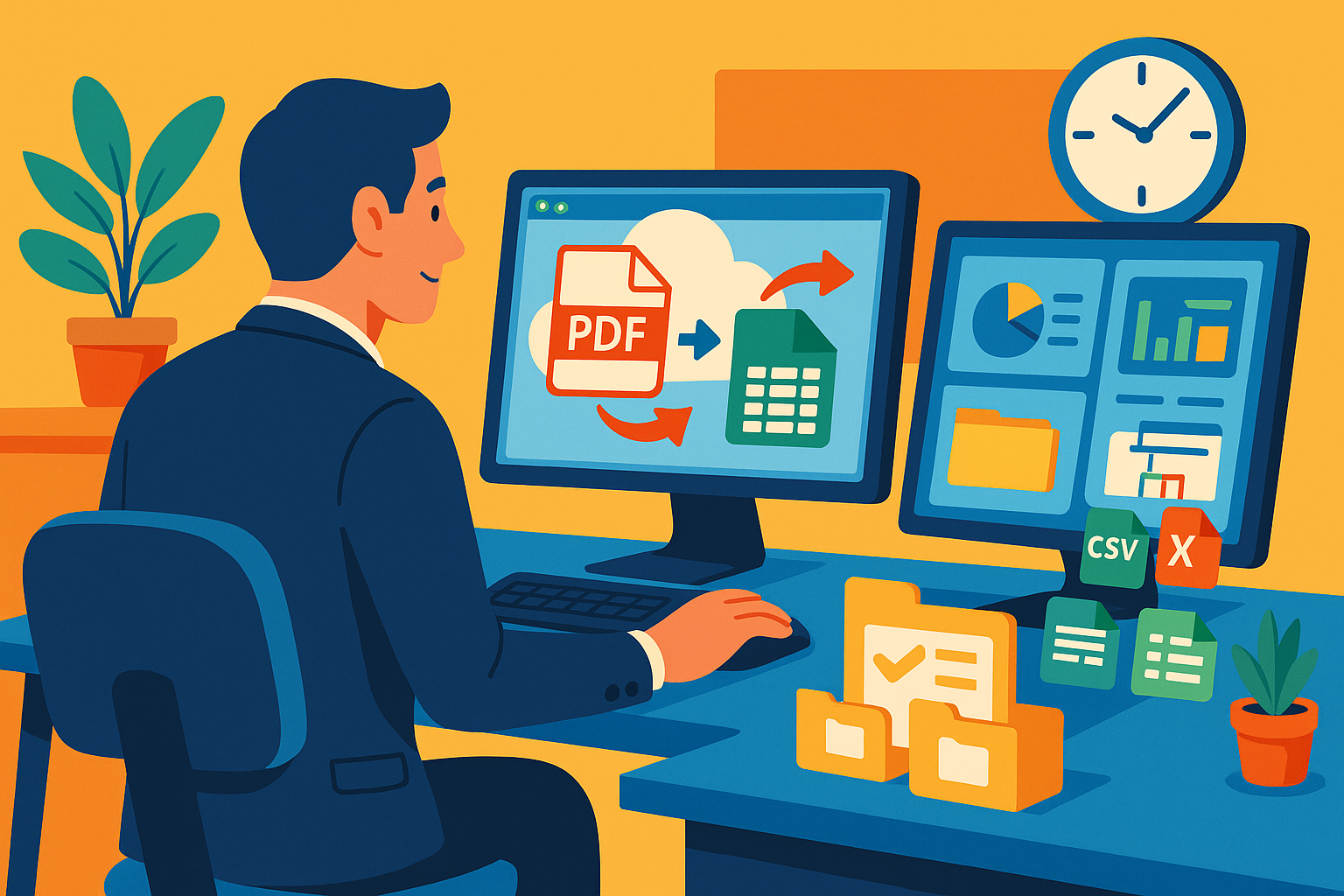How CPAs Can Automate Bank Statement Imports for Faster Month-End Reporting

Bank statement automation for CPAs is transforming the way financial professionals handle month-end reporting. If you’re tired of manual data entry and searching for a faster, more accurate workflow, this step-by-step guide will show you how to implement automation using tools like Rocket Statements. Discover how to convert PDF and image statements into spreadsheets, manage documents in the cloud, and streamline your entire process for efficient, reliable financial reporting.
Step-by-Step: Setting Up Bank Statement Automation with Rocket Statements
Automating bank statement imports is a game changer for CPAs looking to speed up month-end reporting. With Rocket Statements, you can convert PDF and image statements into spreadsheets, manage documents securely in the cloud, and export data in formats compatible with Excel, QuickBooks, and more. Follow this step-by-step guide to implement bank statement automation for CPAs and eliminate manual data entry headaches.

1. Create Your Rocket Statements Account and Set Up Cloud Folders 📂
- Sign up for a Rocket Statements account on our homepage.
- Organize client documents by creating folders and subfolders in the cloud. This makes it easy to manage monthly statements for multiple clients.
- Adjust sharing permissions if you collaborate with team members or clients.
💡 Tip: Keeping folders organized by client and month streamlines your workflow and ensures quick access during audits or tax prep.
Explore more about why Rocket Statements is the one tool every accountant needs in this article.
2. Upload and Convert Bank Statements Automatically 🏦
- Drag and drop PDF or image files into your designated folder.
- Rocket Statements uses advanced OCR to extract transaction data and convert it into spreadsheet-ready formats (CSV, Excel, JSON, or QuickBooks-compatible files).
- Review the extracted data for accuracy. You can edit or categorize transactions as needed before exporting.
💡 Tip: Automate financial data entry for CPAs by setting up recurring uploads or batch processing for high-volume clients.
For a deeper dive into how OCR-powered bank statement converters work, check out our guide for accountants and bookkeepers.
3. Export, Integrate, and Accelerate Month-End Reporting ⏩
- Export the converted data directly to Excel, CSV, or QuickBooks formats.
- Import the files into your accounting software for reconciliation and reporting.
- Use Rocket Statements’ cloud-based document management to store, search, and retrieve statements anytime.
💡 Tip: Learn how to automate monthly reconciliations and reduce manual errors in our step-by-step reconciliation automation guide.
By following these steps, you can leverage bank statement automation for CPAs to save hours each month and deliver faster, more accurate financial reports. For more automation tips and resources, visit our blog.
Tips for Maximizing Month-End Reporting Efficiency
Automating bank statement imports is a game-changer for CPAs aiming to speed up month-end reporting. By leveraging bank statement automation for CPAs, you can reduce manual data entry, minimize errors, and ensure your financial data is always accurate and up to date. Tools like Rocket Statements streamline the process, letting you convert PDF or image statements into spreadsheet formats, organize documents in the cloud, and export data directly into accounting software. Here are actionable tips to optimize your month-end reporting with bank statement tools, so your accounting workflow automation for advisors is seamless and efficient.

1. Set Up Automated Imports and File Organization 🗂️
Start by configuring your bank statement automation tool to automatically import statements from your bank or email. With Rocket Statements, you can organize documents in folders and subfolders for each client and reporting period. This structure makes it easy to locate, review, and reconcile statements quickly. For more on organizing your workflow, check out our guide on how to automate monthly reconciliations.
2. Convert Statements to Compatible Formats for Accounting Software 📊
Use your automation tool to transform bank statements into formats that work seamlessly with your accounting software. Rocket Statements allows you to export data as CSV, Excel, JSON, or QuickBooks-compatible files. This step eliminates manual re-entry and streamlines data imports. Learn how to convert PDF bank statements to Excel or CSV for tax prep or import bank statements directly into QuickBooks for smoother month-end closes.
3. Leverage AI and OCR for Accurate Data Extraction 🤖
Modern tools like Rocket Statements use AI-assisted OCR to extract transaction data from scanned or PDF statements with high accuracy. This technology reduces the risk of human error and speeds up reconciliation. For a deeper dive into how AI-driven automation improves efficiency, see our article on the one tool every accountant needs in 2024.
💡 Tip: Regularly review your automation workflows and update folder structures as your client base grows to maintain efficiency.
Looking for more insights on month-end reporting with bank statement tools? Explore our blog for the latest tips and best practices.
Common Mistakes to Avoid When Automating Bank Statement Imports
Automating bank statement imports can save CPAs countless hours, but common pitfalls can slow down or even derail your workflow. Understanding these mistakes—and how to sidestep them—ensures smoother bank statement automation for CPAs. Let’s troubleshoot the most frequent issues, so you can automate financial data entry for CPAs with confidence and speed.
1. Uploading Unsupported File Formats 📄
Many automation tools, including Rocket Statements, support a wide range of file types, but not all formats are created equal. Uploading low-quality scans or unsupported file types (like password-protected PDFs) can cause failed imports or inaccurate data extraction.
💡 Tip: Always check your statement files before uploading. For best results, use clear, unencrypted PDFs or high-resolution images. Learn more about compatible formats and best practices in our Bank Statement Converter for Accountants and Bookkeepers guide.
2. Overlooking Data Mapping and Categorization Errors 🗂️
Automated tools rely on correct data mapping to ensure transactions are categorized accurately. Skipping the review step or using outdated templates can cause misclassifications, which affect month-end reporting and reconciliation.
- Double-check mapping templates before each import
- Use Rocket Statements’ preview features to validate data
- Regularly update templates as bank statement formats change
For more on streamlining categorization, see our post on How to Automate Monthly Reconciliations.
3. Ignoring Cloud Document Organization 🗃️
Automating imports is only half the battle—mismanaged folders and document chaos can slow down audits and reporting. Failing to organize statements in the cloud makes it difficult to locate files when you need them most.
- Create a folder structure by client, month, or bank
- Use Rocket Statements’ cloud management features to keep files accessible and secure
- Set up permissions for team members as needed
For advanced tips on document management and automation, check out RocketStatements: The One Tool Every Accountants Need in 2024.
⚠️ Warning: Disorganized cloud storage can lead to version control issues and compliance risks. Always review your folder setup before onboarding new clients.
Take the Next Step Toward Seamless Bank Statement Automation
Implementing bank statement automation for CPAs is a game-changer for month-end reporting. By using tools like Rocket Statements, you can automate financial data entry, eliminate manual errors, and accelerate your accounting workflow. Rocket Statements empowers advisors to convert PDF and image bank statements into spreadsheets, manage documents in the cloud, and export files in CSV, Excel, JSON, or QuickBooks-compatible formats. This not only saves valuable time but also ensures data accuracy and security. For those interested in deepening their understanding of OCR technology, our guide on OCR for CPAs and financial advisors provides additional insights. Ready to streamline your month-end reporting with bank statement tools? Try Rocket Statements today and experience the benefits of accounting workflow automation for advisors firsthand.